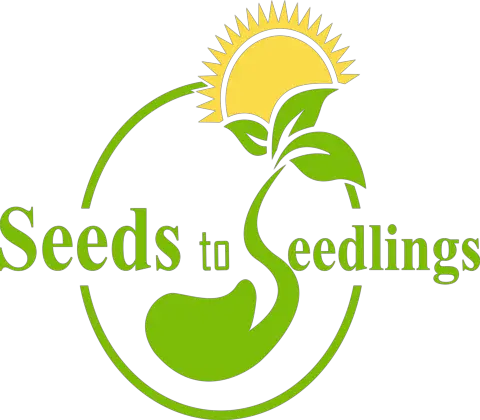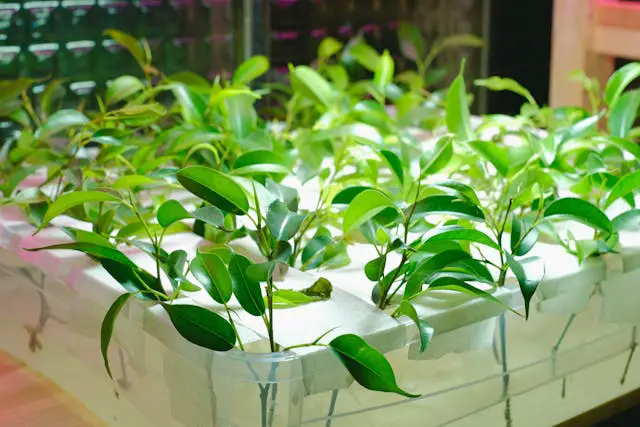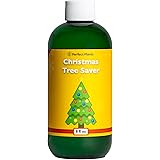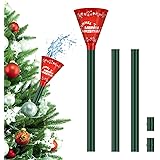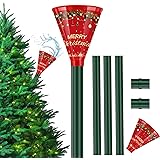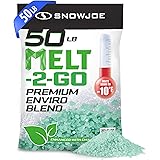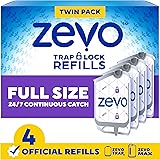Are you ready to cultivate lush, vibrant plants indoors, regardless of the season or your geographical location? In 2025, the world of horticultural lighting is being revolutionized by LED technology. No longer are we limited by the constraints of natural sunlight. With the right LED grow lights, you can provide your plants with the exact spectrum and intensity of light they need to thrive, leading to increased yields, faster growth, and healthier specimens.
This comprehensive guide will navigate you through the latest advancements, trends, and regulations surrounding LED grow lights, empowering you to make informed decisions and choose the best options for your specific needs!
Why Choose LED Grow Lights in 2025?
The evolution of grow lights has been remarkable. From incandescent bulbs to fluorescent tubes and high-pressure sodium (HPS) lamps, each technology has had its advantages and drawbacks. However, LED (Light Emitting Diode) technology has emerged as the frontrunner, offering a compelling combination of efficiency, effectiveness, and longevity. Let’s delve into the key reasons why LEDs are the superior choice for plant growth in 2025:
Energy Efficiency
One of the most significant benefits of LED grow lights is their energy efficiency. Compared to traditional lighting systems like HPS and metal halide (MH) lamps, LEDs consume significantly less electricity to produce the same amount of light. This translates to lower energy bills and a reduced carbon footprint. In a world increasingly focused on sustainability, this is a crucial factor for both home growers and commercial operations.
Statistics: Studies show that LED grow lights can reduce energy consumption by up to 75% compared to HPS lamps. This can result in substantial cost savings over the lifespan of the lights.
Customizable Light Spectrum
Plants require different wavelengths of light for different stages of growth. LEDs offer the unique ability to customize the light spectrum to match the specific needs of your plants. By combining diodes that emit different wavelengths (e.g., blue, red, white), manufacturers can create tailored light recipes for vegetative growth, flowering, and fruiting. This precision allows you to optimize plant development and maximize yields.
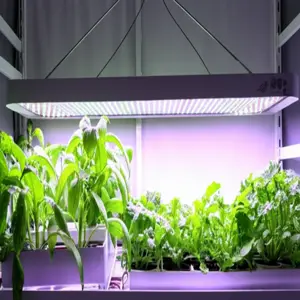
grow lights
Example: Blue light is crucial for vegetative growth, promoting strong stems and leafy foliage. Red light, on the other hand, is essential for flowering and fruiting.
Long Lifespan
LED grow lights boast an impressive lifespan compared to other lighting technologies. A high-quality LED fixture can last for 50,000 hours or more, which translates to several years of continuous use. This reduces the frequency of replacements, saving you time and money in the long run. While the initial investment in LED lights may be higher, their longevity makes them a cost-effective solution over time.
Reduced Heat Output
Excessive heat can be detrimental to plant health, leading to stress, dehydration, and even burns. LED grow lights generate significantly less heat than HPS and MH lamps. This reduces the need for expensive cooling systems and allows you to place the lights closer to your plants, maximizing light intensity without causing damage. The reduced heat also minimizes the risk of fire hazards.
Environmental Benefits
LEDs are a more environmentally friendly option compared to traditional grow lights. They do not contain harmful substances like mercury, which is found in fluorescent lamps. Their energy efficiency also contributes to a lower carbon footprint. Furthermore, the long lifespan of LEDs reduces waste and minimizes the need for frequent replacements.
Understanding the Science Behind LED Grow Lights
To make informed decisions about LED grow lights, it’s essential to understand the underlying science. Let’s explore the key concepts and terminologies:
Photosynthesis and Light Spectrum
Photosynthesis is the process by which plants convert light energy into chemical energy (sugars) to fuel their growth. Chlorophyll, the green pigment in plants, absorbs light most efficiently in the blue (400-500 nm) and red (600-700 nm) regions of the electromagnetic spectrum. These regions are often referred to as the photosynthetically active radiation (PAR).
While blue and red light are crucial, other wavelengths also play a role in plant development. For example, green light can penetrate deeper into the leaf canopy and contribute to photosynthesis in lower leaves. Far-red light can influence plant morphology and flowering.
PAR, PPF, and PPFD
Understanding these metrics is crucial for evaluating the effectiveness of LED grow lights:
- PAR (Photosynthetically Active Radiation): The range of light wavelengths (400-700 nm) that plants can use for photosynthesis.
- PPF (Photosynthetic Photon Flux): The total amount of PAR light emitted by a grow light per second, measured in micromoles per second (µmol/s). A higher PPF indicates a more powerful light.
- PPFD (Photosynthetic Photon Flux Density): The amount of PAR light that reaches a specific area of the plant canopy per second, measured in micromoles per square meter per second (µmol/m²/s). PPFD is a more accurate measure of light intensity at the plant level.
Key Takeaway: When choosing LED grow lights, focus on PPF and PPFD values rather than wattage. Wattage only indicates the power consumption, not the light output that is beneficial to plants.
Light Spectrum and Plant Growth Stages
As mentioned earlier, different light spectra are optimal for different stages of plant growth:
- Vegetative Stage: Requires a higher proportion of blue light to promote strong stem growth, leafy foliage, and overall plant vigor.
- Flowering Stage: Requires a higher proportion of red light to stimulate flower and fruit development. Far-red light can also be beneficial during this stage.
Some LED grow lights offer adjustable spectrum controls, allowing you to fine-tune the light output to match the specific needs of your plants throughout their lifecycle.
Types of LED Grow Lights: A 2025 Overview
The market for LED grow lights is diverse, with various types available to suit different needs and budgets. Here’s an overview of the most common types in 2025:
LED Panels
LED panels are flat, rectangular fixtures that typically use multiple small LEDs arranged in a grid pattern. They are a popular choice for small to medium-sized grow areas due to their relatively low cost and even light distribution. LED panels are generally lightweight and easy to install.
Pros: Affordable, lightweight, even light distribution.
Cons: May not have the highest PPFD, limited spectrum control in some models.
LED Bars
LED bars are long, narrow fixtures that can be arranged to provide targeted lighting for specific areas of the plant canopy. They’re great for covering large areas by placing several in a row. They are often used in vertical farms and commercial greenhouses. They offer good light penetration and can be customized to deliver the desired spectrum.
Pros: Excellent light penetration, customizable spectrum, suitable for vertical farming.
Cons: Can be more expensive than LED panels, requires careful placement to ensure even light distribution.
COB (Chip-on-Board) LEDs
COB LEDs consist of multiple LED chips packed closely together on a single substrate. This allows for a higher light intensity from a smaller area. COB LEDs are known for their efficiency and ability to penetrate the plant canopy effectively. However, they can generate more heat than other types of LEDs.
Pros: High light intensity, excellent penetration, efficient.
Cons: Can generate more heat, may require additional cooling.
Quantum Boards
Quantum boards are a relatively new type of LED grow light that has gained popularity in recent years. They consist of a large, thin board with numerous small LEDs evenly distributed across the surface. Quantum boards are known for their energy efficiency, even light distribution, and full-spectrum output. They are a popular choice for both hobbyist and commercial growers.
Pros: Excellent energy efficiency, even light distribution, full-spectrum output, low heat output.
Cons: Can be more expensive than LED panels.
Spider-Style LEDs
Spider-style LEDs feature multiple LED bars or pods radiating from a central hub, resembling a spider’s legs. This design provides excellent light coverage and penetration, making them suitable for larger grow areas and plants with dense canopies. They are often used in commercial cultivation facilities.
Pros: Excellent light coverage and penetration, suitable for large areas.
Cons: Can be expensive, may require more headroom.
Table: Comparison of LED Grow Light Types
| Type | Pros | Cons | Best For |
|---|---|---|---|
| LED Panels | Affordable, lightweight, even light distribution | Lower PPFD, limited spectrum control in some models | Small to medium-sized grow areas |
| LED Bars | Excellent light penetration, customizable spectrum, suitable for vertical farming | More expensive, requires careful placement | Vertical farms, commercial greenhouses |
| COB LEDs | High light intensity, excellent penetration, efficient | Can generate more heat | Small to medium-sized grows where penetration is key |
| Quantum Boards | Excellent energy efficiency, even light distribution, full-spectrum output, low heat output | Can be more expensive than LED panels | Hobbyist and commercial growers |
| Spider-Style LEDs | Excellent light coverage and penetration, suitable for large areas | Expensive, may require more headroom | Commercial cultivation facilities |
Top LED Grow Lights of 2025: Our Recommendations
Based on our research and analysis of the latest products, here are some of the best LED grow lights available in 2025, categorized by their strengths and target users:
Best Overall: The High-Performance All-Rounder
Brand & Model: Spider Farmer SE1000W
Why it’s great: The Spider Farmer SE1000W is a powerhouse, delivering exceptional PPFD and coverage for a 5×5 ft grow area during flowering. It uses high-quality Samsung LM301B diodes, offering a full spectrum with IR and UV, and has a dimming function for customizing light intensity throughout the plant’s life cycle. Its build quality is excellent, and the price is competitive for its performance class.
Ideal for: Growers who need a powerful and versatile light for both vegetative and flowering stages, covering a relatively large area.
Best for Small Spaces: Compact and Efficient
Brand & Model: Mars Hydro TS 1000
Why it’s great: The Mars Hydro TS 1000 is perfect for smaller grow tents or closet grows. It is energy-efficient, produces minimal heat, and provides a full spectrum suitable for all growth stages. It’s also incredibly affordable, making it an excellent entry point for beginners. The light’s compact size and light weight make it easy to install and position.
Ideal for: Hobbyist growers with limited space, beginners, and those on a budget.
Best for Commercial Growers: High-Intensity and Scalable
Brand & Model: Fluence SPYDR 2x
Why it’s great: Fluence SPYDR 2x is a top-of-the-line LED bar system designed for large-scale commercial operations. It provides exceptional light uniformity and penetration, resulting in consistent yields across the entire grow area. The SPYDR 2x is known for its robust construction, energy efficiency, and advanced control options. Fluence are known for their research, data and consistent performance.
Ideal for: Commercial cannabis growers, vertical farms, and other large-scale cultivation facilities.
Best Budget Option: Affordable Entry into LED Growing
Brand & Model: Viparspectra P1000
Why it’s great: The Viparspectra P1000 provides a surprisingly good performance at a very affordable price point. It offers a full spectrum suitable for all growth stages, and its compact design makes it easy to use in small spaces. Although it may not have the highest PPFD, it’s a great option for beginner growers who want to experience the benefits of LED lighting without breaking the bank.
Ideal for: Beginner growers, those on a tight budget, and hobbyists with small grow areas.
Best for Supplemental Lighting: Enhancing Existing Setups
Brand & Model: Horticulture Lighting Group (HLG) 65 V2
Why it’s great: The HLG 65 V2 is a compact and efficient quantum board that’s ideal for supplementing existing grow setups or for small individual plants. It offers a full-spectrum output with high efficiency, and it’s incredibly easy to install. Its low heat output allows you to place it close to the plants without causing damage.
Ideal for: Growers who want to supplement existing lighting, those growing single plants, and anyone needing a small, efficient light.
Choosing the Right LED Grow Light: A Step-by-Step Guide
Selecting the perfect LED grow light for your needs can seem daunting, but by following a structured approach, you can make an informed decision. Here’s a step-by-step guide:
Step 1: Determine Your Grow Space Size
The size of your grow space is the most crucial factor in determining the appropriate size and number of LED grow lights you’ll need. Measure the length, width, and height of your grow tent or room. This will help you calculate the square footage of your growing area.
Example: If your grow tent is 4 feet long and 4 feet wide, your grow space is 16 square feet.
Step 2: Consider the Types of Plants You’re Growing
Different plants have different light requirements. Leafy greens and herbs typically require lower light levels than flowering plants like cannabis or tomatoes. Research the specific light requirements of the plants you intend to grow. Consider the light intensity and spectrum requirements.
Step 3: Calculate the Required PPFD
Based on the type of plants you’re growing, determine the optimal PPFD (Photosynthetic Photon Flux Density) for each stage of growth. Here’s a general guideline:
- Seedlings: 200-400 µmol/m²/s
- Vegetative Stage: 400-600 µmol/m²/s
- Flowering Stage: 600-900 µmol/m²/s (or higher for some plants)
Keep in mind that these are just guidelines, and the optimal PPFD may vary depending on the specific plant species and cultivar.
Step 4: Evaluate Light Coverage and Distribution
Ensure that the LED grow light you choose provides adequate coverage and even light distribution across your entire grow area. Look for PPFD maps or PAR charts provided by the manufacturer to assess the light output at different distances and locations.
Tip: Overlapping the coverage areas of multiple smaller lights can often provide more even light distribution than relying on a single large light.
Step 5: Consider Spectrum Control and Dimmability
If you want to optimize plant growth for different stages, consider LED grow lights with adjustable spectrum controls. Dimmable lights allow you to adjust the light intensity to match the specific needs of your plants and reduce energy consumption during certain periods.
Step 6: Factor in Heat Management
Choose LED grow lights with efficient heat dissipation mechanisms, such as heat sinks or cooling fans. This will help prevent overheating and maintain optimal growing conditions. Consider the ambient temperature of your grow space and the amount of ventilation required.
Step 7: Read Reviews and Compare Products
Before making a purchase, read reviews from other growers and compare different LED grow light models. Look for independent tests and comparisons that provide objective data on light output, efficiency, and reliability. Online forums and communities can offer valuable insights and user experiences.
Step 8: Set a Budget and Prioritize Features
LED grow lights range in price from affordable to very expensive. Determine your budget and prioritize the features that are most important to you, such as light output, spectrum control, energy efficiency, and lifespan. Don’t necessarily choose the cheapest option; invest in a quality product that will provide reliable performance and long-term value.
Optimizing Your LED Grow Light Setup
Once you’ve chosen the right LED grow lights, it’s essential to optimize your setup to maximize their effectiveness. Here are some key tips:
Proper Distance and Positioning
The distance between your LED grow lights and your plants is crucial. Too close, and you risk burning the plants. Too far, and they won’t receive enough light. Consult the manufacturer’s recommendations for optimal hanging height. As a general rule, start with the lights farther away and gradually lower them until you achieve the desired PPFD levels.
Tip: Use a light meter to measure PPFD at different points on the plant canopy and adjust the light height accordingly.
Environmental Control
Maintaining a stable and optimal environment is essential for plant growth. This includes controlling temperature, humidity, and airflow. Use fans to circulate air and prevent hot spots. Install a dehumidifier or humidifier as needed to maintain the appropriate humidity levels for your plants.
Nutrient Management
Proper nutrient management is crucial for plant health and growth. Provide your plants with the right balance of nutrients at each stage of their lifecycle. Use a high-quality nutrient solution and monitor pH and PPM levels regularly. Soil testing is recommended.
Training and Pruning
Plant training techniques, such as topping, low-stress training (LST), and screen of green (ScrOG), can help maximize light exposure and increase yields. Prune away any dead or yellowing leaves to improve airflow and prevent disease. Consider researching training methods suitable for your plants.
Monitoring Plant Health
Regularly inspect your plants for signs of nutrient deficiencies, pests, or diseases. Address any issues promptly to prevent them from spreading and affecting plant growth. * ***Use a magnifying glass*** * to inspect for pests.
Current Trends in LED Grow Lights (2025)
The field of horticultural lighting is constantly evolving. Here are some of the key trends shaping the LED grow light market in 2025:
Full-Spectrum LEDs
Full-spectrum LEDs, which emit a broad range of wavelengths across the visible spectrum, are becoming increasingly popular. These lights mimic natural sunlight more closely and provide plants with a more balanced light environment. Research suggests that full-spectrum lighting can enhance plant growth, flavor, and nutritional value. Further research will be required to find what spectrum is most beneficial to certain plants.
Smart Grow Lights with IoT Integration
Smart grow lights with Internet of Things (IoT) integration are gaining traction. These lights can be controlled remotely via smartphone apps and can be programmed to adjust light intensity and spectrum automatically based on plant needs. IoT integration also allows for data collection and analysis, providing growers with valuable insights into plant performance.
UV and IR Supplementation
Some LED grow lights now include ultraviolet (UV) and infrared (IR) diodes. UV light can enhance resin production and pest resistance in some plants, while IR light can promote flowering and fruiting. However, the use of UV and IR light requires careful monitoring and control, as excessive exposure can be harmful to plants.
Increased Focus on Energy Efficiency
With rising energy costs and growing environmental concerns, there is an increasing focus on energy efficiency in LED grow lights. Manufacturers are developing more efficient diodes and optimizing light designs to minimize energy consumption. Look for lights with high PPF/watt ratios.
Vertical Farming Applications
LED grow lights are playing a crucial role in the growth of vertical farming. Vertical farms are indoor facilities that grow crops in stacked layers, maximizing space utilization and resource efficiency. LEDs provide the precise light spectrum and intensity required for optimal plant growth in these controlled environments.
Regulations and Standards for LED Grow Lights
The LED grow light industry is subject to various regulations and standards to ensure product safety, performance, and energy efficiency. Here are some of the key regulations to be aware of:
UL Certification
Underwriters Laboratories (UL) is a globally recognized safety certification organization. UL certification indicates that a product has been tested and meets established safety standards. Look for LED grow lights with UL certification to ensure they are safe to use.
Energy Star Rating
Energy Star is a program of the U.S. Environmental Protection Agency (EPA) that promotes energy efficiency. Energy Star-rated LED grow lights meet specific energy efficiency requirements and can help reduce energy consumption and lower electricity bills.
FCC Compliance
The Federal Communications Commission (FCC) regulates electronic devices to prevent electromagnetic interference. LED grow lights should comply with FCC regulations to ensure they do not interfere with other electronic equipment.
RoHS Compliance
The Restriction of Hazardous Substances (RoHS) directive restricts the use of certain hazardous materials in electrical and electronic equipment. RoHS compliance ensures that LED grow lights do not contain harmful substances like lead, mercury, and cadmium.
Local and State Regulations
In some areas, there may be local or state regulations regarding the use of grow lights for certain types of plants, such as cannabis. Be sure to check your local and state laws before setting up a grow operation.
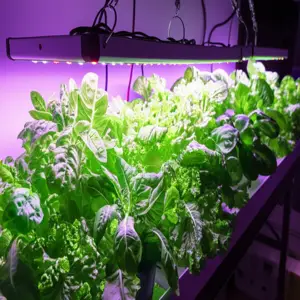
plant lighting
Troubleshooting Common LED Grow Light Problems
Even with the best LED grow lights, you may encounter occasional problems. Here are some common issues and how to troubleshoot them:
Light Burn
Symptom: Leaves turning yellow or brown, especially at the top of the plant.
Cause: Lights are too close to the plants or the light intensity is too high.
Solution: Raise the lights or dim the intensity. Increase airflow to help dissipate heat. Consider using a shade cloth to reduce light intensity.
Nutrient Deficiencies
Symptom: Yellowing leaves, stunted growth, abnormal leaf shapes.
Cause: Lack of essential nutrients in the soil or nutrient solution.
Solution: Test the soil or nutrient solution to determine the nutrient levels. Adjust the nutrient balance as needed. Use a high-quality nutrient solution specifically formulated for the type of plants you’re growing.
Pest Infestations
Symptom: Visible insects on plants, damaged leaves, sticky residue.
Cause: Pests entering the grow area.
Solution: Inspect plants regularly for pests. Use organic pest control methods, such as neem oil or insecticidal soap. Introduce beneficial insects to control pest populations. Ensure proper sanitation and ventilation to prevent pest infestations.
Mold and Mildew
Symptom: White or gray powdery substance on leaves, stems, or buds.
Cause: High humidity and poor airflow.
Solution: Improve airflow by using fans. Reduce humidity levels by using a dehumidifier. Apply a fungicide to control mold and mildew. Remove affected plant parts.
Light Flickering or Failure
Symptom: Lights flickering or not turning on.
Cause: Loose wiring, faulty ballast, or damaged LEDs.
Solution: Check the wiring connections to ensure they are secure. Replace the ballast if it is faulty. If the LEDs are damaged, contact the manufacturer for a warranty replacement or repair. Ensure that the lights are properly grounded.
Real-World Examples of LED Grow Light Success
The benefits of LED grow lights are evident in numerous real-world examples:
Commercial Cannabis Cultivation: Many commercial cannabis growers have switched to LED grow lights to reduce energy costs, improve plant quality, and increase yields. For example, one large-scale cannabis farm in California reported a 40% reduction in energy consumption and a 20% increase in yield after switching to LED lighting.
Vertical Farming: Vertical farms are increasingly relying on LED grow lights to provide the precise light spectrum and intensity required for optimal plant growth. Companies like AeroFarms and Plenty are using LED technology to grow leafy greens, herbs, and other crops in urban environments, reducing transportation costs and environmental impact.
Home Gardening: Home gardeners are also embracing LED grow lights to extend the growing season and cultivate plants indoors. Many hobbyist growers are using LED panels and quantum boards to grow herbs, vegetables, and flowers in their homes, regardless of the weather conditions outside.
Research and Development: Researchers are using LED grow lights to study the effects of different light spectra on plant growth and development. This research is leading to new insights into plant physiology and helping to optimize LED lighting systems for specific plant species and cultivars.
The Future of LED Grow Lights
The future of LED grow lights is bright, with ongoing advancements and innovations promising to further enhance their performance, efficiency, and versatility. Here are some potential future developments:
Advanced Spectrum Control
Future LED grow lights may offer even more precise spectrum control, allowing growers to fine-tune the light output to match the specific needs of their plants at different stages of growth. This could involve the use of dynamic spectrum control systems that automatically adjust the light spectrum based on plant feedback.
AI-Powered Lighting Systems
Artificial intelligence (AI) could play a greater role in optimizing LED lighting systems. AI algorithms could analyze plant data, such as leaf color, growth rate, and nutrient levels, and automatically adjust the light spectrum and intensity to maximize plant health and productivity.
Wireless Control and Monitoring
Wireless control and monitoring of LED grow lights will become more prevalent, allowing growers to remotely manage their lighting systems and track plant performance. This could involve the use of cloud-based platforms that provide real-time data and analytics.
Integration with Other Smart Home Devices
LED grow lights may be integrated with other smart home devices, such as thermostats, humidifiers, and ventilation systems, to create a fully automated and controlled growing environment. This could simplify the growing process and improve overall plant health and yields.
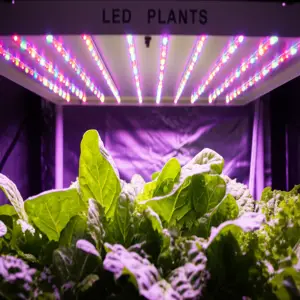
horticultural lighting
Development of New LED Technologies
Ongoing research is focused on developing new LED technologies with improved efficiency, lifespan, and light output. This could lead to the development of more powerful and energy-efficient LED grow lights that can further reduce energy consumption and lower operating costs.
FAQ: Frequently Asked Questions About LED Grow Lights
What are the best LED grow lights for beginners?
For beginners, LED panels like the Mars Hydro TS 1000 or Viparspectra P1000 are excellent choices. They are affordable, easy to set up, and provide a full spectrum suitable for all growth stages. Their low heat output also makes them forgiving for those new to indoor growing. These are popular options among new growers since they are easy to learn and understand.
How much do LED grow lights cost?
The cost of LED grow lights varies greatly depending on the size, type, features, and brand. Small LED panels can cost as little as $50, while high-end commercial-grade LED systems can cost several thousand dollars. Generally, you can expect to pay between $100 and $500 for a decent-quality LED grow light for a small to medium-sized grow area.
How long do LED grow lights last?
High-quality LED grow lights typically have a lifespan of 50,000 hours or more. This translates to several years of continuous use. The actual lifespan may vary depending on the operating conditions and the quality of the components used in the light fixture.
Can I use LED grow lights for all types of plants?
Yes, LED grow lights can be used for all types of plants. However, different plants have different light requirements. It’s important to choose LED grow lights with a spectrum and intensity that are appropriate for the specific plants you intend to grow. Research on ideal light conditions can assist growers with their selection.
What is the optimal distance between LED grow lights and plants?
The optimal distance between LED grow lights and plants depends on the light intensity, the type of plants, and the stage of growth. As a general rule, start with the lights farther away and gradually lower them until you achieve the desired PPFD levels. Consult the manufacturer’s recommendations for optimal hanging height.
Do LED grow lights produce heat?
Yes, LED grow lights do produce heat, but they generate significantly less heat than traditional lighting systems like HPS and MH lamps. The amount of heat produced depends on the wattage and efficiency of the LED fixture. Proper heat management is still important to prevent overheating and maintain optimal growing conditions.
What is the difference between full-spectrum and narrow-spectrum LED grow lights?
Full-spectrum LED grow lights emit a broad range of wavelengths across the visible spectrum, mimicking natural sunlight. Narrow-spectrum LED grow lights emit light in specific wavelengths, such as blue or red, that are known to be important for plant growth. Full-spectrum lights are generally preferred for overall plant health and growth, while narrow-spectrum lights can be used to target specific growth stages.
Are LED grow lights energy efficient?
Yes, LED grow lights are highly energy efficient compared to traditional lighting systems. They consume significantly less electricity to produce the same amount of light. This translates to lower energy bills and a reduced carbon footprint. Calculate your costs to see the benefit of the switch.
What is PPFD, and why is it important?
PPFD (Photosynthetic Photon Flux Density) is the amount of PAR light that reaches a specific area of the plant canopy per second, measured in micromoles per square meter per second (µmol/m²/s). PPFD is a more accurate measure of light intensity at the plant level than wattage. It is important because it directly affects the rate of photosynthesis and plant growth.
Can I use LED grow lights in a small apartment?
Yes, you can use LED grow lights in a small apartment. LED grow lights are a great option for small spaces because they don’t produce as much heat as traditional grow lights. Make sure that there is proper ventilation and keep the lights at a safe distance from flammable materials.
Final Thoughts
The landscape of horticultural lighting is constantly evolving, and LED technology has firmly established itself as the superior choice for plant growth in 2025. By understanding the science behind LED grow lights, carefully selecting the right fixtures for your needs, and optimizing your growing environment, you can unlock the full potential of indoor cultivation. Whether you’re a hobbyist grower, a commercial farmer, or a researcher, LED grow lights offer a powerful and versatile tool for achieving your plant-growing goals.
As we look to the future, the advancements in LED technology promise to further enhance their performance, efficiency, and versatility. From advanced spectrum control to AI-powered lighting systems, the possibilities are endless. By staying informed about the latest trends and regulations, you can ensure that you’re always using the best possible technology to support your plant growth endeavors. Stay up to date with the latest research in horticultural LED technology, and don’t be afraid to experiment and adapt your approach as new innovations emerge.
Investing in quality LED grow lights is an investment in the future of your garden. With their long lifespan, energy efficiency, and customizable spectrum, LED lights provide the tools you need to cultivate thriving plants indoors, regardless of the season. So, embrace the power of LED technology and embark on a journey of growth, abundance, and sustainable cultivation.
Auto Amazon Links: No products found.
Perfect Plants Christmas Tree Saver 8oz. | Easy Use Xmas Tree Preserver Food | Have Healthy Green Christmas Trees All Holiday Season
$9.97 (as of December 3, 2025 00:36 GMT +00:00 - More info- Product prices and availability are accurate as of the date/time indicated and are subject to change. Any price and availability information displayed on [relevant Amazon Site(s), as applicable] at the time of purchase will apply to the purchase of this product.
Kaiedos Christmas Tree Watering Funnel - 39 Inch Funnel, Reusable Design, Makes Watering Your Live Tree a Snap!
$14.99 (as of December 3, 2025 00:36 GMT +00:00 - More info- Product prices and availability are accurate as of the date/time indicated and are subject to change. Any price and availability information displayed on [relevant Amazon Site(s), as applicable] at the time of purchase will apply to the purchase of this product.
Christmas Tree Watering Funnel, Real Christmas Tree Water Long Funnel About 40 Inch, Trees Watering System for Water Indoor Outdoor
$15.99 (as of December 3, 2025 00:36 GMT +00:00 - More info- Product prices and availability are accurate as of the date/time indicated and are subject to change. Any price and availability information displayed on [relevant Amazon Site(s), as applicable] at the time of purchase will apply to the purchase of this product.
IPOOLTENG Christmas Tree Watering Funnel 3 Tube 1 Funnels 40 Inch - 3 Section Plastic Christmas Tree Funnel Waterer, Long Funnels for Watering Trees, Best Gifts for Your Parents to Water Tree
$15.53 (as of December 3, 2025 00:36 GMT +00:00 - More info- Product prices and availability are accurate as of the date/time indicated and are subject to change. Any price and availability information displayed on [relevant Amazon Site(s), as applicable] at the time of purchase will apply to the purchase of this product.
1 Pack Christmas Tree Watering Funnel System, 44 Inch Christmas Tree Watering Stick with Adjustable 3-Section Design, Reusable & Spill-Free, Xmas Plant Waterer Tool for Indoor and Outdoor
$16.99 (as of December 3, 2025 00:36 GMT +00:00 - More info- Product prices and availability are accurate as of the date/time indicated and are subject to change. Any price and availability information displayed on [relevant Amazon Site(s), as applicable] at the time of purchase will apply to the purchase of this product.
Cuisinart 6.5" Cast Iron Smashed Burger Press, Round Flat Edge Grill Press for Crispy Smash Burgers, Burger Tool for Grill and Griddle Accessories, for BBQs and Tailgates
$24.99 (as of December 3, 2025 16:48 GMT +00:00 - More info- Product prices and availability are accurate as of the date/time indicated and are subject to change. Any price and availability information displayed on [relevant Amazon Site(s), as applicable] at the time of purchase will apply to the purchase of this product.
Muddy Mat® Shown on TV Super Absorbent Microfiber Dog Door Mat for Muddy Paws, Non-Slip Washable Pet Rug, Quick Dry Chenille Entryway Carpet, Machine Washable Indoor Outdoor mat, Grey 30"x19"
$19.95 (as of December 3, 2025 16:48 GMT +00:00 - More info- Product prices and availability are accurate as of the date/time indicated and are subject to change. Any price and availability information displayed on [relevant Amazon Site(s), as applicable] at the time of purchase will apply to the purchase of this product.
Snow Joe Premium Enviro Blend Ice Melt, Green-Coated Deicer Crystals, 50 lb - Safer Melter for Vegetation, Concrete & Metals w/ Anti-Corrosion Calcium Magnesium Acetate
$32.97 (as of December 3, 2025 16:48 GMT +00:00 - More info- Product prices and availability are accurate as of the date/time indicated and are subject to change. Any price and availability information displayed on [relevant Amazon Site(s), as applicable] at the time of purchase will apply to the purchase of this product.
OLANLY Dog Door Mat for Muddy Paws 30x20, Absorbs Moisture and Dirt, Absorbent Non-Slip Washable Doormat, Quick Dry Chenille Mud Mat for Dogs, Entry Indoor Entryway Carpet for Inside Floor, Grey
$9.99 (as of December 3, 2025 16:48 GMT +00:00 - More info- Product prices and availability are accurate as of the date/time indicated and are subject to change. Any price and availability information displayed on [relevant Amazon Site(s), as applicable] at the time of purchase will apply to the purchase of this product.
Zevo Flying Insect Trap Official Refill Cartridges - Fits Both Zevo Trap & MAX Indoor Fly Trap - Authentic Trap+Lock Technology to Catch Gnats, House & Fruit Flys (4 Official Refill Cartridges)
$14.97 (as of December 3, 2025 16:48 GMT +00:00 - More info- Product prices and availability are accurate as of the date/time indicated and are subject to change. Any price and availability information displayed on [relevant Amazon Site(s), as applicable] at the time of purchase will apply to the purchase of this product.
